Indoor vegetable growth provides fresh food, making them perfect for yearly production. However, some vegetables require specific care, such as full sun exposure, potting soil, and storage issues. This makes it difficult for busy gardeners to grow them with little attention. On the other hand, cucumbers are easy to grow and have a yearly, round nature, making them a great option for gardeners.
Cucumbers are tender, climbing plants known for their cool crunch in summer salads. They can grow well in greenhouses and can trail on the ground, making it easy to grow perfect-sized cucumbers. These plants also thrive well in cold frames or sunny outdoor spots.
This climbing plant has many varieties, each offering a fruitful harvest to be shared with friends. Growcycle offers gardeners multiple harvesting tips and tools to ensure the healthy growth of home growing cucumbers.
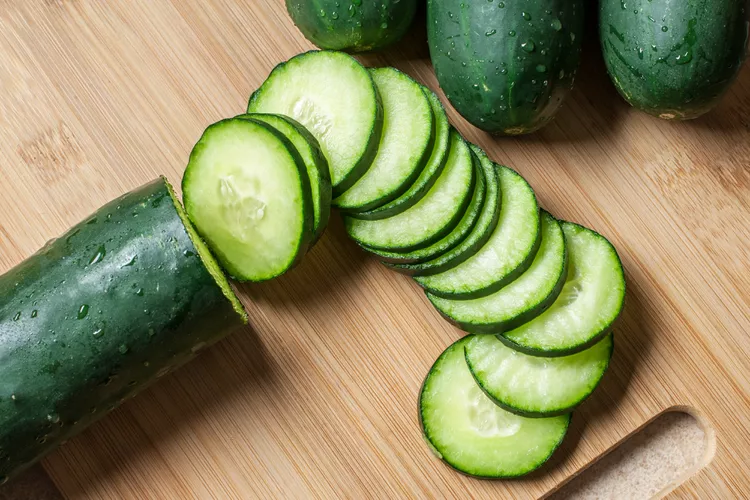
Botanical Description
Cucumbers, called Cucumis sativus, are part of the gourd family Cucurbitaceae. These vegetables are commonly grown in gardens across all regions of Minnesota.
Root
- The plant has a fibrous root system that spreads out like a mat and can grow 25 to 28 inches deep.
- However, healthy cucumber roots are white and firm, while rootbound plants have restricted growth because their roots circle in the pot.
- The roots are about 6 millimeters wide near the surface and get thinner below 12 inches.
Stems
- The plants have a single main stem.
- Other branching stems or clusters of leaves extend from that main stem.
- Usually, the stems are rough, succulent, and trailing.
Tendril
- These modified stems act like springs, helping the plant climb and attach to structures by curling around objects.
- They consist of two layers of cells containing lignin, a rigid organic polymer, with more lignin in the inside layer, making it stiffer.
Leaves
- The cucumber leaves are mostly grown alternatively on the vines. They are heart-shaped or round, with 3-7 pointed parts.
- Its leaves are green, edible, and taste delicate when young.
- They are about 3-6 inches long and wide, with a prickly, rough texture covered in hairs.
Flowers
- Cucumber flowers are yellow and have five petals. They are unisexual and have different parts, such as sepals, petals, and stamens.
- It can contain both male and female flowers, known as monoecious, or only female flowers, called gynoecious.
Fruit
- The fruit of this plant is a type of berry called pepo, with a hard rind and no internal sections.
- They are typically cylindrical and tapered, up to 62 cm long and 10 cm wide.
- Mostly, its fruits contain 95% water.
Growth Habit
Usually, cucumber has different growth habits depending on its variety,
- Vining cucumbers grow on strong vines and can be grown on a trellis or fence to improve airflow and reduce disease risk.
- Bush cucumbers are compact and do not need a trellis, making them perfect for containers or small raised beds.
Characteristics of Cucumbers
Cucumbers are refreshing, versatile, and water-rich vegetables that add taste and nutrients to various dishes.
Appearance
- Color: The most common cucumber color is green, but they can also be yellow, orange, white, or brown. The color varies depending on the variety of cucumber.
- Shape: This vegetable can be cylindrical, spherical, or even slightly flat, ellipsoid, or obovoid. It can also be small and round or long and snake-like.
- Size: The smaller types of cucumber are mostly around 4 inches long, and the larger ones reach 6-8 inches. Mini cucumbers are 5-8 inches long, and pickling cucumbers are usually 3-7 inches long.
- Skin: Cucumber skin is the edible outer layer and contains important nutrients like fiber and vitamin A. Mostly, its skin is smooth or spiky, from yellow-green to dark green. Even some cucumbers have a wax coating to stay fresh.

Flavor and Aroma
It has a light and refreshing taste, like a mix of water and mild melon. It is slightly sweet with a touch of earthiness. Due to its high water content, it has a cooling sensation when eaten. It has a fresh, green aroma with a slight grassy scent.
Texture
The texture of cucumbers is crisp and watery, with moist, transparent flesh and visible seeds. Further, this vegetable has long, cylindrical, and bright green skin, giving it a soft and refreshing feel.
Advantages of Growing Fresh Cucumbers at Home
Growing fresh cucumbers at home offers multiple benefits such as:
- Easy to Grow: This vegetable is easy to grow, thrives in warm weather, and produces a lot of quality fruit. With only enough water and sunlight, it can be grown directly from seed in the garden with little effort.
- Saves a Lot of Space: As climbing plants, cucumbers can grow up supports instead of trailing on the ground, making them more space-efficient. Hence, vertical growth of cucumber saves space in the garden.
- High Nutrient Value: Cucumbers contain vitamins A, C, K, magnesium, potassium, and calcium. Vitamin K supports blood clotting and bone health, while calcium is important for strong bones. Potassium can also help to improve heart health.
- Yearly Production: Cucumbers are harvested yearly, making the fresh product available throughout the year. However, different regions have different harvesting times, depending on the variety.
Growing Cucumbers Indoor
Cucumbers can be grown throughout the year with the right growing conditions and proper plantation.
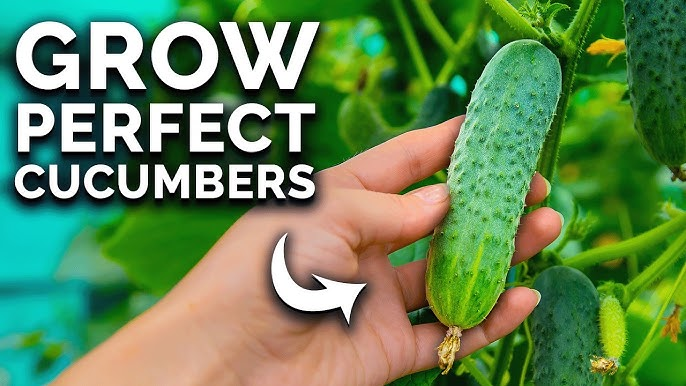
Step 1: Choose the Right Cucumber Plant
Choosing the right plant depends on the growing conditions and space. Gardeners need to understand a few things before choosing it, such as;
- Varieties: Indoor cucumbers grow well in greenhouses, polytunnels, or cold frames, while outdoor varieties thrive in sunny, sheltered spots.
- Size: Small or mini cucumbers produce fruit faster, and gherkin varieties are ideal for pickling.
- Grafted Plants: These are vigorous, disease-resistant, and produce larger harvests over a longer season but can be more expensive with a limited variety.
Step 2: Select the Proper Location
Choose a suitable place for growing lettuce for healthy growth.
- Garden: Grow lettuce in soil that drains well and is rich in compost.
- Container: A large container of around 30 cm in width filled with multi-purpose compost is needed for container-grown lettuce.
- Shade: Use shade cloth or a mini hoop tunnel to protect lettuce from the sun, especially in hot weather.
Step 3: Prepare the Ground
Although the cucumber is a vertical growth variety, it can be grown in gardens, containers, or a mini hoop tunnel. So, make sure to prepare the ground well by providing:
- Proper Sunlight: Place the pot where the plant gets enough daylight to grow well.
- Soil: Use fertile and well-draining soil, and add compost and organic matter before planting.
- Soil pH: Ensure the soil pH is between 6.5 and 7, as it ensures healthier growth.
Step 4: Plant the Seeds
Cucumbers are best to grow indoors for an earlier harvest but can also be planted outside in mild climates.
- Indoors: Start seeds indoors to start the growing season early. After about a month, the seedlings will be ready to transplant outside as they grow quickly.
- Outdoors: For outdoor planting, sow seeds directly into the soil once it has warmed up, typically in early summer.
Step 5: Thin the Seedling
Thinning helps these plants to grow better. So, it is better to thin the seedlings when they reach about 4 inches tall. Here, make sure to be careful about the spacing part:
- For rows, leave about 1 to 1.5 feet between seedlings.
- For mounds, keep only the strongest seedling.
- For supports, space seedlings around a foot apart.
Step 6: Provide Support
Cucumbers grow best when they climb, saving space in small gardens. In this case, if help is needed, gardeners can do it this way;
- Use Support: Use bamboo canes, netting, or trellises to help the vines climb.
- Train the Veins: As they grow, make sure the vines stay on the support, especially when they start bearing fruit.
Step 7: Water Regularly
Start watering the plant regularly, but do not overwater it. It is better to water about an inch weekly. In hot weather, gardeners can water it more. However, avoid wetting the leaves, as this can cause disease.
Step 8: Fertilize the Plant
Fertilize the cucumber plant with organic liquid or slow-release granules specially made for vegetables. Gardeners can feed it during planting and throughout the growing season. Adding compost can also help improve its growth.
Care Tips for Healthy Growth of Cucumber
Cucumbers are versatile and fast-growing plants that thrive with proper attention. Here are some essential care tips to ensure healthy growth:
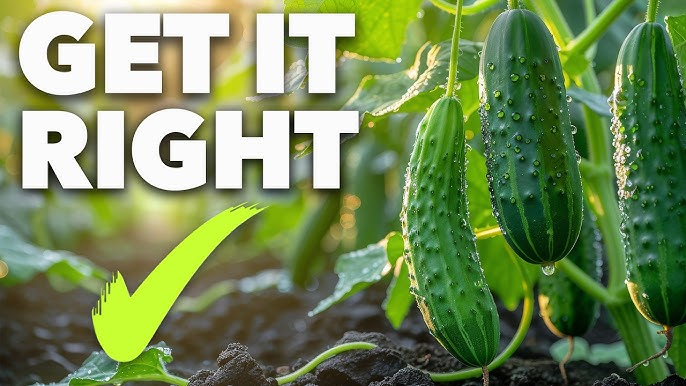
1. Water
This plant needs regular watering, with at least 1 inch per week, especially with less rainfall. However, it is important to water consistently, especially when the fruit starts growing, as lack of water can result in the bitter taste of cucumbers.
2. Sunlight
Cucumbers need 6-8 hours of direct sunlight daily to grow well. However, gardeners can use artificial light while growing indoors for healthier production. In low light, there are chances of stunted growth and less fruit production of the cucumber plant.
3. Trellis Support
Due to cucumbers' vining growth pattern, they need support to keep plants off the ground for healthier growth and easier harvesting. Gardeners can make a trellis support by using wooden slats to form a lattice.
However, galvanized metal cattle panels can also be used vertically or horizontally for support. These supports help cucumbers grow upwards, promoting better airflow and reducing disease.
4. Fertile Soil
Cucumbers grow well in loose, well-drained soil rich in organic matter with a pH between 6.0 and 6.8. However, this plant can tolerate a wider pH range, and slightly acidic soil is preferred. Gardeners can add lime if the soil has a low pH. They can also add well-decomposed manure or compost before planting.
5. Temperature and Humidity
Cucumbers thrive in temperatures between 75 and 85°F. Since they are not cold-hardy, gardeners are advised to protect them from low temperatures. These plants do not need any extra humidity, but they should be watered regularly for healthy growth.
Harvest Cucumbers
Here is a simple guide to harvesting cucumbers at the right time for the best flavor and quality:
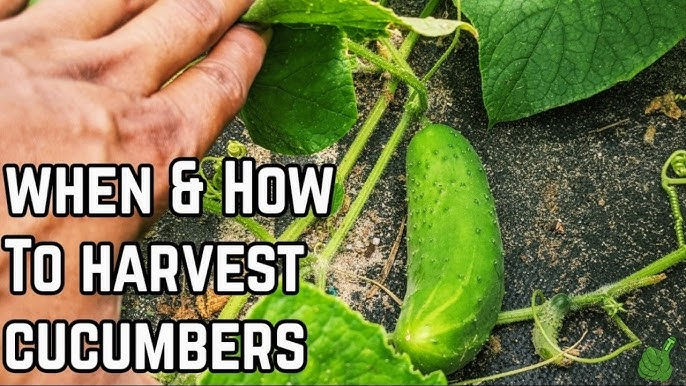
1. Choose the Right Time
Cucumbers are typically ready for harvest 50 to 70 days after planting. Harvest when they reach the right size and color for their variety. When ripe, most cucumbers turn deep green, though some cultivars may appear white, yellow, or dappled. Here are some guidelines about popular varieties;
- When the pickling cucumbers reach 2 inches long, harvest them.
- Harvest the plant at 3 to 4 inches in length for dill pickles.
- Harvest slicing cucumbers for fresh eating when they are 6 to 9 inches long and dark green.
2. Prepare for Harvest
Before harvesting cucumbers, it is important to prepare essential tools and be careful,
- Wear gloves: Some varieties of cucumber, particularly pickling types, can have prickly spines, so wear gloves to protect the hands.
- Use sharp tools: Cut the cucumber from the vine with a sharp knife or pruner, leaving about one inch of stem attached.
3. Harvesting Process
- Remove any stunted, overripe, or damaged fruits during harvesting. It will ensure the better and ripened growth of plants.
- Use garden shears or pruners to cut ripe cucumbers cleanly, leaving about ¼ inch of stem attached. It will help avoid damaging the vine.
- Gardeners must carefully handle long, burly cucumbers, as they bruise easily.
- Gently place harvested fruits in a basket or box to protect them from injury.
4. Extend the Season
Harvest cucumbers early for better flavor and more fruit production. Gardeners can sow seeds indoors for a head start and grow different varieties. However, damaged fruit must be removed to increase growth, and harvesting must be done regularly. Before the first frost, prune small fruits and flowers to focus on ripening larger cucumbers.
Uses of Home Grown CucumberS
Homegrown cucumbers can be used for multiple things. Here are some practical and creative ways to use them:
Health Uses
- Treat Dehydration: This vegetable has 95% water and is mostly used to meet daily fluid needs. It also contains electrolytes, which help prevent dehydration, especially in hot weather or after exercise.
- Reduce Inflammation: Cucumbers, which mostly have anti-inflammatory properties, can reduce redness, irritation, and inflammation. They can also soothe sunburn and reduce puffiness around the eyes.
- Control Blood Sugar: Cucumbers are low in carbs and high in fiber, which helps control blood sugar levels. The fiber slows down the digestion of sugar and carbs.
- Hair Health: Cucumber juice is usually rich in nutrients that help prevent hair loss, strengthen hair, and support healthy growth. It also hydrates the skin and can make hair shiny. Mixing cucumber juice with lemon juice can reduce dandruff and scalp dryness.
Cosmetic Uses
- Removes Dark Circles: It helps reduce swelling and lighten skin around the eyes. Cucumber slices, eye pads, and gels can soothe the skin and reduce puffiness and dark circles.
- Moisturizer and Toner: It can be used in a toner made with honey, aloe vera, and water. Cucumber hydrosol and a sugar-mint scrub also help refresh and hydrate the skin.
- Treats Acne-prone Skin: It can help reduce redness and swelling, cleanse and tighten pores, and remove dirt and excess oil to detoxify the skin. However, this vegetable's cooling effect also calms irritated skin, helping to prevent future breakouts.
Cooking Uses
- Picklings: Cucumbers are great for pickling, making them tangy and crunchy. They are soaked in vinegar, water, and spices like dill. Pickles are tasty in sandwiches, salads, or as a snack.
- Salads: They are commonly used in salads to add a fresh crunch and mild taste to multiple dishes. They mix well with other vegetables and herbs, making the salad more delicious.
- Soup: It makes refreshing soups, perfect for hot weather. However, it mixes well with yogurt, herbs, and spices for a light, creamy flavor.
- Smoothie: Cucumber, pineapple, and banana are commonly used in smoothies. This refreshing, fruity drink makes a healthy snack or breakfast.
Common Problems of Cucumber and How to Fix It
Cucumber plants can face several common issues, from pests to growth challenges, but certain methods can fix them.
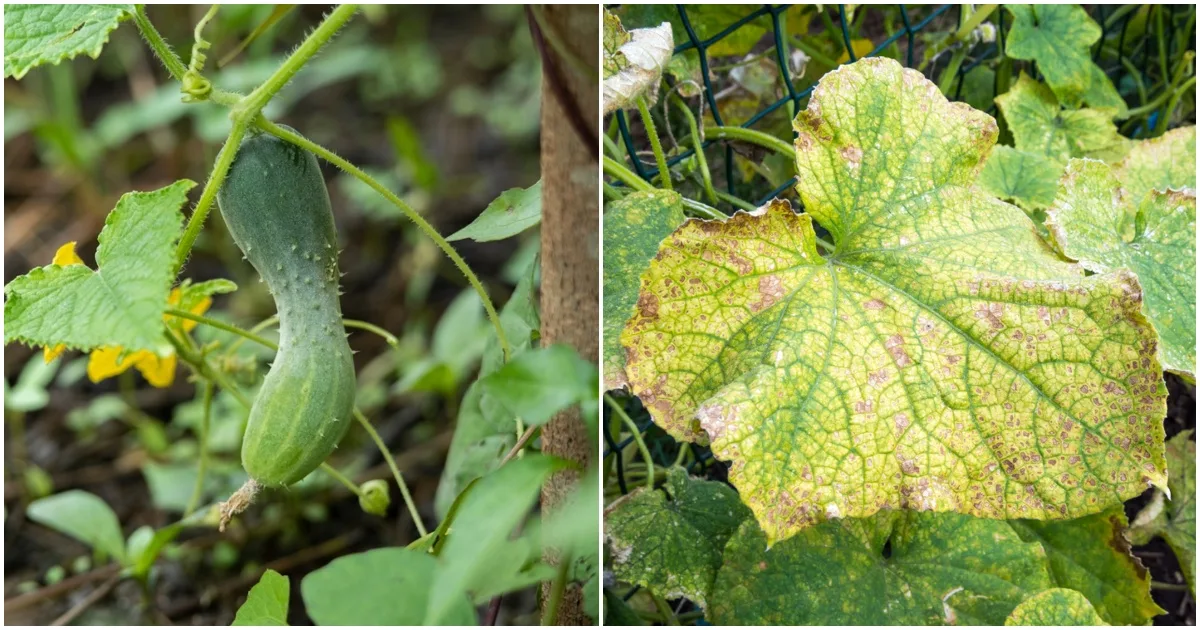
1. Leaf Rot
Cause: Overwatering, underwatering, diseases, and pests.
Solution:
- Do not overwater; only water when the top inches get dried out.
- Only water the plant once a week, as it can avoid sogginess.
- Use neem oil or insecticidal soap to clean the infected leaves.
2. Undeveloped Fruit
Cause: Poor pollination.
Solution:
- Do the hand pollination. Use a small paintbrush to transfer pollen from one male plant to another to produce fruit.
- Start planting insect-friendly plants near the cucumber plant, as it will attract bees and insects.
3. Bacterial Wilt
Cause: Bacterium named as Erwinia tracheiphila.
Solution:
- Immediately remove the infected plant leaves and avoid planting in the same place.
- Protect the young plant by using the floating cover.
- Use insecticides to control pest attacks and avoid spreading the disease further.
4. Angular Leaf Spot
Cause: Bacterium called Pseudomonas syringae pv. lachrymans.
Solution:
- Choose seeds free from diseases or pest attacks, as they can damage the whole plant.
- Do not do overhead watering; start looking for drip irrigation methods.
- Use clean and sanitized tools before harvesting or planting, which can further spread the disease.
FAQs
Why do cucumbers sometimes taste bitter?
Cucumbers can taste bitter due to a compound called cucurbitacin, a natural defense mechanism. Stress factors like heat, drought, or irregular watering can mostly cause bitterness.
Are cucumbers good for pets?
Yes, cucumbers have around 95% water, making them safe and hydrating for pets, especially dogs. However, always remove or cut the seeds into smaller pieces for easier digestion.
Can cucumbers grow without pollination?
Although most cucumber varieties need pollination for quick and better fruit production, some varieties, such as Parthenocarpic, can grow without pollination.
The Bottom Line
The cucumber is a climbing green indoor vegetable that produces heart-shaped leaves and edible cylindrical fruits yearly. This vegetable plant's vining and bushy growth make it a perfect choice to decorate indoor gardens using a little space.
Its high water content, nutritional value, and versatile uses make it the best indoor vegetable for growing healthy plants. Visit Growcycle to get premium quality cucumber seeds for the healthy growth of plants.
Disclaimer: This material is for informational purposes only and should not be relied on for legal, medical, financial, or any other form of professional advice.
About the Author
Environmental Journalist Focused on Sustainable Agriculture
Victor Miller is an environmental journalist at Growcycle, where he covers the latest news, trends, and innovations in sustainable agriculture. He has a deep passion for storytelling that emphasizes ecological balance and responsible farming practices.
Before joining Growcycle, Victor worked for several agricultural and environmental publications, reporting on significant environmental issues and interviewing key figures in the sustainability sector. His work has been featured in various industry journals and online platforms.

